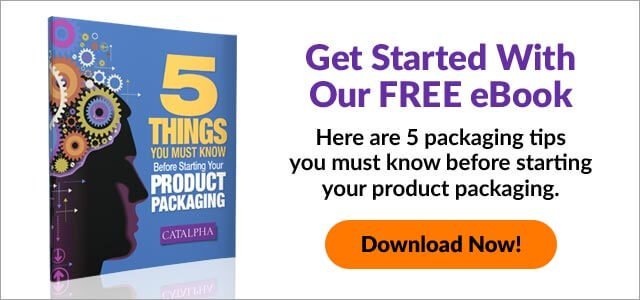
From time to time, I interview different package suppliers to give my blog readers a better understanding of the type of packaging that is available to them.
I hope this type of interview brings clarity to those that want plastic packaging, but just don’t have the knowledge of where to start.
Following is a conversation I had with PowerPak, a blister & clamshell manufacturer in San Diego, who also sells blister or clamshell sealing machinery. They have a very long history of blister packaging, in fact, they invented the process in 1949!
They are very aware that many start up manufacturers are trying to get their product packaged using the blister or clamshell method and have developed the machinery and the network of contract packagers that can get your product packaged no matter where you are in the country and no matter the quantity.
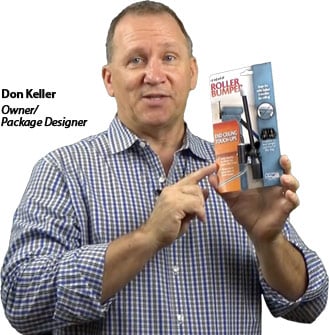
Want Us To Do It All For You?
Best Package For You - We’ll determine the best type and size of package that fits your product and your budget.
Design - We’ll create a design that will stand out from your competition.
We’ll Get it Printed - Don’t be left with a pretty design and nothing else. We can also print your package so you can get it on the shelf and sold!
This interview is with Bob Green, owner of PowerPak and Robin Green, Business Development Manager, also of PowerPak.
Don: Ok, thanks Robin & Bob for joining me.
Maybe you could give me a little background on your company. I know you’re a family business and I know that you do plastic packaging and have other services & products.
You also sell the machinery too?
So, I just thought if you could just start with a little bit of a background, and Bob just so you know, my plan here is to transcribe this recording so that I could use it on our blog, because a lot of our readers, I get a fair amount of readers coming to our blog from different searches that they do about packaging, and we get a lot of phone calls and they point at the blister packaging sample designs I have on my website and ask how they can do that.
So, I think this would be very helpful for them. So Robin if you don’t mind, give us the background.
Robin: Yes, my grandfather actually invented blister package in 1949.
He was trying to prevent pilferage in the store.
Their products were all in big barrels, all the items, and they had a stealing problem. So, he worked on a solution to prevent people from stealing. That’s how Blister packaging came about.
He had worked in the printing industry for many years, and he developed a way to create a chemical reaction between PVC and the board and he came up with Blister packaging.
That’s where it really all began. And then, my uncle who also worked in the trade since he was very young, he moved out to California, started PowerPak in California, and he actually has the patent.
Bob you want to take it from here?
Bob: Yeah, actually PowerPak was started in 1984 in Montreal.
Bob: So, as far as blister packaging, what PowerPak has developed is not only blister 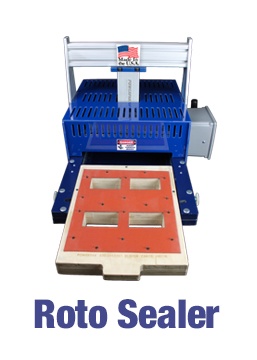 packs, it has developed the machine like that first machine to be built were big bulky machines.
packs, it has developed the machine like that first machine to be built were big bulky machines.
We said we want to come up with a way to make them more compact and easier to work with and we developed a machine and patented our equipment over 20 years ago already.
And now we developed a new machine that is for smaller guys that are just starting out, they can look at the website it’s called the Roto Sealer.
It's a pretty innovative thing cause sealing tray is double boarded so it turned a one-station machine into a two-station machine.
The biggest thing we invented also was the way to seal clamshells, which is plastic to plastic packaging, without RF sealing, without sonic welding, just with simple heat.
And the magic is in the tooling that we make. We are a manufacturer. We manufacture the equipment in house AND the supplies, we are basically are a one stop shop.
We’ve been married to a few different companies for the cards, the blisters, the clamshells, but basically we’re a one-stop shop.
Don: Ok, so you don’t actually create the plastic shells or you do?
Bob: We do, we can form prototypes in our shop, and we actually, as far as production, we work with different plants all over the country. Wherever the customer is, we can find the right combination, to save money for the customer.
Don: I know that usually is the first question or maybe the second question that people have when we talk. It’s all about pricing. I don’t know if you find that as well?
When somebody is interested in doing blister packages, do you suggest that they start at a certain quantity?
Bob: Yes, we have a minimum quantity of 6,250 cards, so if you figure out the average cost of a blister card is based on a square inch, and it’s all ganged up on a sheet, it’s gang-run, so the average cost is let’s say, 5 cents a card, so you’re looking at a whopping $312.15.
So it’s not a lot of money to shell out for the card. It’s just putting 4 colors on the front, 1 color in the back. We can also do fold over packs, everything is done in a gang system so you don’t have to pay for printing plates.
All you have to do is email us the art.
Don: Okay, and that would be up to a certain size?
Bob: Well, what I’m saying is based on the square inch, so anything under let’s say 25 square inches, let’s say you have a 4x6 card, you’re under it.
I mean, it’s very rare that the cards are more than let’s say 5 cents, because how of how big they are, it just depends on the size of the packaging.
Don: Alright. Okay, and then there’s the plastic blister itself, and that has to be created, correct?
Bob: Yeah, and we have lots of stock. If its just a square, a round, a rectangle we have hundreds of stock sizes, we could even go in quantities of thousands if need be, we could match it up to 6,250, and we also have a gang-run. If we don’t have the size, the cost of a mold is about $500 and then we have to run 12,500 blisters.
The average cost of a blister, you know, by the time you’re finished with everything, the cards, the blisters, the assembly and everything, you have probably got 15 cents a package. Does it pay to go overseas to China?
Don: Well, I agree, everybody is doing these smaller quantities, they definitely would like to do it here.
Now, I talked to Robin about this briefly the other day, but if somebody had, say they’re on the east coast, you guys are on the west, it wouldn’t make sense to ship their product all the way out to the west coast.
Bob: No, no, we have an east coast plant.
Don: Okay, and your east coast connection here, they would take the blisters and the cards and put your product in place and do the sealing, correct?
Bob: Well, let’s say the cards and blisters we would manufacture in our east coast plant.
Don: So the whole job will be done on the east coast?
Bob: Exactly, yeah. And then as far as contract packaging, we build the machines, so we have machines that contract packagers who like to do the assembly, where that’s 6,250 or small runs like that, you want to sell the customer machines, you know, a small machine sells for roughly $4000.
So for $4000 it’s not a huge investment. They start out and they do it themselves.
Don: Yeah, definitely that’s what we’re gonna be doing, a lot of blisters,
I mean, that makes sense, once they get going. Now when you buy a machine do you have to do different tooling, or things if they ever change, like if it’s a one-product situation, I get that, you’re set, but if it ends up being multiple products with multiple sizes then you need a little extra tooling there.
Bob: The sealing trays, they’re all custom made, we definitely do it in house here in San Diego, and usually anywhere from $200-250 a tray, and it’s a one-time thing.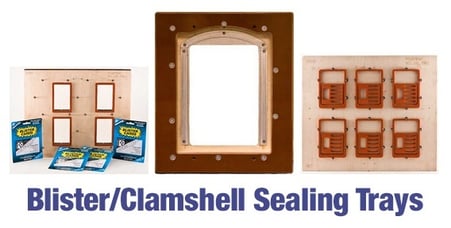
Don: Okay, very good. So now, that’s for a blister that we’ve been speaking about, correct?
Bob: Yes, that would be for regular blisters.
Don: Okay, because I think a lot of my readers probably have some confusion between a blister and clamshell.
Bob: They have no clue, right?
Don: Right, and tell me, chime in here if I’m not explaining this correctly, but a blister is a one-sided piece of plastic that is vacuum formed, it could possibly be formed to the shape of your product OR you have some stock situations. And that formed blister, gets heat-sealed to the card.
Bob: Exactly, there’s a coating on the card, and when it’s heated up, the blister reacts with the coating of the card and it takes about 2½ to 3 seconds to seal, so it’s very important.
We have a lot of companies saying, “Hey we can go into the blister packaging industry”, and they do.
For instance, printers call us all the time, they print 100,000 cards and they don’t put a coating on it, they have no clue what they’ve done, and it doesn’t seal! So I say, ‘send us the art’ and we’ll help you out.

Want Us To Do It All For You?
Best Package For You - We’ll determine the best type and size of package that fits your product and your budget.
Design - We’ll create a design that will stand out from your competition.
We’ll Get it Printed - Don’t be left with a pretty design and nothing else. We can also print your package so you can get it on the shelf and sold!
Don: Alright, now a clamshell is just that, it looks like a clam’s shell, it’s got a hinge, on one side, but it’s one piece of formed plastic, but hinged in the middle, and could be formed on both sides, could not be, depends on what’s needed for the product. And now is that something that you are selling a machine for as well?
Bob: Yes, that’s where our 4 station machine comes in, our 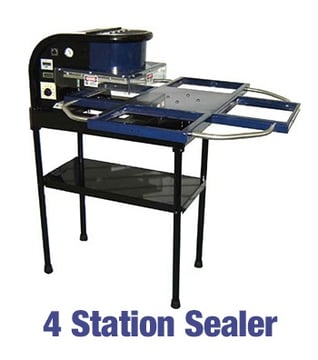 equipment will seal those clam shells, and — bottom line — they do a tremendous because these are 4 stations, the minimum quantity, let’s just say it’s one up at a time, you’ll do 600 an hour. But most clamshells you’ll get 2 after 4 up, you can crank out the same amount as a blister pack. So the magic is in the tooling.
equipment will seal those clam shells, and — bottom line — they do a tremendous because these are 4 stations, the minimum quantity, let’s just say it’s one up at a time, you’ll do 600 an hour. But most clamshells you’ll get 2 after 4 up, you can crank out the same amount as a blister pack. So the magic is in the tooling.
Don: Allright, and a clamshell, that also takes a card, usually some type of an insert card.
Bob: Exactly, we can print the insert card with the gang system, we have a special insert card run for clamshells, as well.
Don: Ok. Now as far as a special die cut of the card, or perhaps, that doesn’t matter?
Bob: You can cut any shape you want.
Don: Okay, very good. Now the typical cost for this 4-station sealing item, is that inexpensive?
Bob: Well, for the 4-station machine that will do both, that will seal blister cards and clamshells is $16,000. It’s still very reasonable compared to an RF sealing machine, the tooling alone for other equipment is much more than our machine sometimes.
Don: Okay, but this is kind of a clamshell that it doesn’t require, as you mentioned earlier, an outside edge heating element?
Bob: No, it’s a top plate on the top that matches up to the heating plate and it will come down and hit the bottom set of tooling and will seal only where it has to seal, on the edge, which is really neat, you know, and from the smallest companies to the biggest companies like Honeywell, Milwaukee tools, Irwin Tools, they’re all been running our equipment for years.
Don: Wow, very good. So again, if someone’s on the east coast, that’s not a problem?
Bob: I think we have more machines on the east coast than we do in the west, even though we’re in the west.
Don: Okay.
Bob: And then, another thing is, a lot of contract packagers, are people with disabilities.
This is a big thing, you know, there are companies called ARC. (Association of Retarded Citizens) Our machines are so user-friendly, they’re very, very user-friendly, so it’s giving people with disabilities jobs, and so if you’re customers don’t want to purchase the equipment at the beginning.
They can give their product out to do their assembly, to our handicapped workshop. And we have handicapped workshops all over the country with our equipment too.
Don: Wow, very good. Okay, so again, your company sells the machinery to seal a blister or clamshell, but you also do the plastic clamshells and form those as well as plastic blisters, and printing the cards or any type of insert that goes into either of those types of packages.
Bob: Exactly
Don: OK, well that’s excellent. I’ll be happy to include some photos in our blog if you have any if you want to send me some?
Robin: Yeah, I’ll send them over, I also wanted to say, if they’re shipping the machine, the freight to the east coast is generally less than $300, so it’s not that expensive to ship the machine.
Don: That’s good, and I assume it’ll take maybe about a week to make that trip?
Robin: Yes.
Don: Okay, so within a week you could be up and sealing your own packages. Well, that’s a good question, so how long does it take for you to do the cards and the blisters or clamshells, what’s the normal turnaround?
Robin: Cards & blisters in the combo run. To make a prototype it takes about a week, and then we run everything, it cuts off on Friday, and it ships two weeks after that Friday.
Don: Okay
Robin: So the cutoff is Friday, ships two weeks later.
Don: I see. Okay, so obviously that’s a gang run so you need to wait for everybody to get their artwork in and then you…
Robin: Well, it doesn’t matter because it cuts off every Friday, it ships no matter what, two weeks later.
Bob: Sometimes sooner.
Don: Okay, what would be the reason for somebody to do their own run, is it just because it’s such a large quantity?
Bob: If they’re doing big volume, if they’re doing millions of packages and they don’t want to wait, that’s when it becomes a dedicated run, they paid for their own plates, dies, and tooling.
When they call us to re-order and they need half a million parts, in half a week we can have them. But it’s very rare that people still rather wait for the gang runs.
Robin: Even if they’re shipping 100,000 at a time every two weeks.
Don: Makes sense. I imagine plates and dyes could be rather expensive.
Bob: It can be a couple of grand.
Don: I know that is a reason that stopped a lot of people from doing corrugate printing too. The litho laminate style of packaging. They thought there was such a high front-end cost to get the package created.
Bob: That’s why using the gang system is a tremendous thing. It just works out very well in our industry. We also have the latest and greatest packaging is also fold over packages.
The clamshells are good for items that are over $10-15.
A blister pack is good for anything under that normally. But now there’s a new type of package that is a folded over card.
Don: Yeah, if you could explain that, that’s a very good option, if you don’t mind.
Bob: Yeah, so basically, the only thing you’re increasing as far as price is, let’s say the card is 5 cents. It becomes 10 cents because it’s a double-sided card.
But the benefit is you get a second card and it makes the package more stable and it just gives you a little bit more advertising room, and if you have a heavier product, it could accommodate a heavier product.
So we do a lot of stuff also like the pet industry so one client does the dog bones. So, we’ll encapsulate two blisters, one protruding out on one side and one protruding out on the other side, and then we pull the card over and you got half the product showing on one side and half on the other.
Don: Okay, and that doesn’t require machine to seal it, or does it?
Bob: Yes, you still need the machine, because just the coating is on the inside instead of the outside.
Don: Okay, I was under the impression that that type of fold over card, didn’t need to be machine sealed.
Bob: Well, there is the type of packaging, it’s called self-latexing, and you don’t need a machine, but the problem with that is let’s say you order 5000 of these self latexing cards and you don’t have a machine, after about 3-4 weeks of getting them, if you don’t package them all right away, well without the machine it’s basically a chemical reaction between the two sides.
It’s like a glue on the back and you pull it over and it sticks immediately. But if you store the cards for more than a month, the cards will be scrap, they will be useless because the chemical reaction will only last so long.
So you have to package all of them at one time. This type of card packaging is like 3 times the price of a regular fold over card.
Don: Alright, well that’s very good to know. I’m glad we spoke of this. Allright, well everything you said has been very, very helpful and I think my readers are really going to enjoy this and learn more about the blister and clamshell packaging.
Don: Okay, is there anything you’d like to add?
Robin: I think we’ve covered it all
Don: OK - Thanks Bob, thanks Robin, and hope to talk to you again soon.
If you have questions regarding blister or clamshell packaging for your product, leave us a note below (or call us) and we'll help you take the next step.
Additional articles you may find helpful
How To Measure Your Product For A Custom Box [with Video]
Packaging Success - Covid Case Studies
The Best Printing For Packaging – Pros And Cons Of 5 Printing Methods



